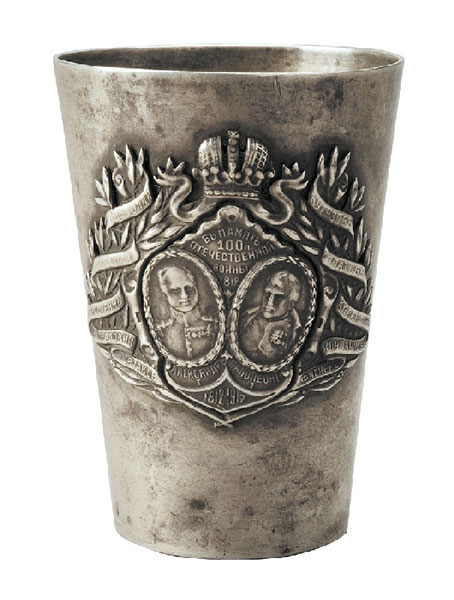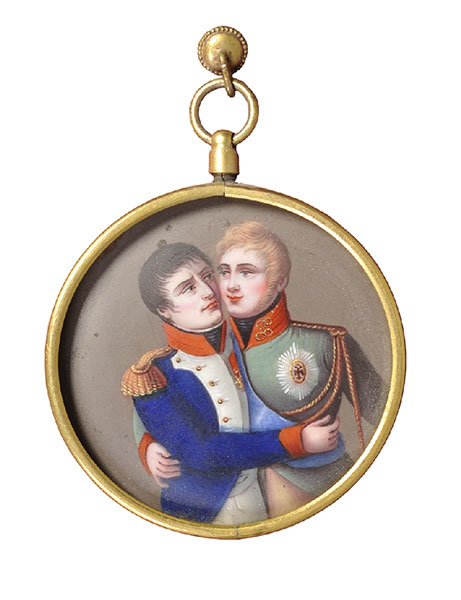
Art vs. Propaganda: Exhibition on Napoleon and Alexander I Opens in Moscow
/ Главная / Russkiy Mir Foundation / Publications / Art vs. Propaganda: Exhibition on Napoleon and Alexander I Opens in MoscowArt vs. Propaganda: Exhibition on Napoleon and Alexander I Opens in Moscow
The Two Emperors exhibition devoted to the 200th anniversary of the Patriotic War of 1812 will be held from February 15 to March 15 in the All-Russian Museum of Decorative, Applied & Folk Art (ARMDA&FA). This exposition is the first in a number of jubilee events to be hosted by Russia in 2012, which has been proclaimed the Year of Russian History. An uncommon perspective was chosen for this “overture”: the relationship between two emperors – Alexander I and Napoleon I. Thematically, the show is split between historic periods and represented by exhibits from a large personal collection of art hunter Alexander Vikhrov, who has been forming it for more than 30 years already, and supplemented with a number of items from the stocks of ARMDA&FA and other collections.

Both the friendship and enmity between Alexander and Napoleon were full of paradoxes: the peacemaking Russian emperor initiated all his wars against France, whereas the militant French emperor was constantly seeking alliance with Russia. “Alexander! We loved each other,” confessed the great captive of St. Helen Island on one occasion.
The two great emperors were linked by epic events of war and peace: Austerlitz, Tilsit, Borodino, the capture of Moscow by the French, the Battle of Nations at Leipzig and, finally, the capture of Paris, each of these events being widely depicted in European art.
Visitors will be treated to an array of numerous items and works of art of the French, Italian, German and Russian origin, which have been created since late 18th century. Fine and graphic arts, medals and coins, ebony, bronze, biscuit and classic porcelain statuettes, decorative plates depicting the most vivid moments in the life of the emperors, snuffboxes, cigarette cases, decorated portraits in little, porcelain and glass items, rare folios and finally some memorable artifacts, including Bonaparte’s signature.
It should be remembered that in those days it was graphic art that was the main bearer of visual information, be it official, glorifying, agitating or denigrating information. Thus the art of caricature became widespread in Europe in the first quarter of the 19th century. It’s interesting to see the difference between the Russian and the French in how they approached ‘official’ propaganda: rather aggressive Napoleon’s plots called to prove the fairness of enthronement of this “man of the people” juxtapose with restrained Russian escapades simply corroborating the crown-bearing status of the Russian emperor.
Incidentally, Napoleon was perhaps the first to use applied arts as an instrument of propaganda – in his reign they started manufacturing what was subsequently described as ‘agitation chinaware.’ Notable samples of the Sevres manufacture are also on display. It should be noted that Russian courtiers quickly took up that style, which is evidenced in the works of Russian craftsmen and artists.
The story of personal relations between the two emperors, their friendship and enmity, the story of unused opportunities for building Europe’s future runs through the entire exposition.

This idea is best represented by Tilsit-related items: here you can see the first meeting of the two emperors in June 1807 – first in a raft-based tent in the middle of the river Neman and then 15 days of close communication in Tilsit, crowned in the signing of the seemingly ‘everlasting’ peace treaty. It is to those days that one of the oldest exhibits goes to: the very first edition of a book about Napoleon in Russian (Napoleon: the French Emperor, 1806). Soon after Tilsit an artifact that could be described as an emblem of the entire show was created: a unique bronze medallion with an enamel image of the two sovereigns warmly hugging each other. The medallion’s reverse side shows that very Neman tent where the first meeting of the emperors took place.
Europe kept a watchful eye on the unexpected rapprochement of Russia and France, responding with numerous graphic caricatures (a British sheet features Bonaparte presenting the Legion of Honor to a brown bear, rather than a Russian grenadier, as was the case) and with what can be described as “caricatures in porcelain.”
Events of the Patriotic War of 1812 are represented in a special way. Not in vain was that war perceived as a turning point in the development of European decorative-applied art. The Empire style of the French-Russian origin was perhaps most saliently manifested in the works of decorative-applied art. Its echoes in the form of military plots would emerge in the art of France and Russia even 100 years after those memorable events. Here is a kettle from the Gardner factory: the medallions feature the scene of Napoleon and Alexander shaking hands at the signing of the Treaty of Tilsit, on one side, and a reproduction of the painting by Vasily Vereshchagin Moscow in Fire: Return from Peter’s Palace as evidence to the guile of the French, on the other side. You can admire another pearl from Vikhrov’s collection dated from the beginning of the 20th century – a vase from the Imperial Porcelain Works representing another painting by Vereshchagin – Napoleon on the Field of Borodino.
The triumphant march of the allied forces led by Alexander I, as they were entering Paris, was also reflected in the works of art and items of craftsmen inspired by the glory and valor of Russian troops. The theme of the Patriotic War and related events does not vanish with the passage of time; neither does the interest of modern-day artists in such significant figures of the world history as Napoleon I and Alexander I.
Source:All-Russian Museum of Decorative, Applied & Folk Art
New publications

 Mikhail Kalatozov, a director who transformed the world of cinematography in many ways, was born 120 years ago. He was a Soviet film official and a propagandist. Above all, he was capable of producing movies that struck viewers with their power and poetic language.
Mikhail Kalatozov, a director who transformed the world of cinematography in many ways, was born 120 years ago. He was a Soviet film official and a propagandist. Above all, he was capable of producing movies that struck viewers with their power and poetic language.  Ukrainian authorities have launched a persecution campaign against the canonical Ukrainian Orthodox Church (UOC), the biggest one in the country's modern history. Over the past year, state sanctions were imposed on clergy representatives, searches were conducted in churches, clergymen were arrested, criminal cases were initiated, the activity of the UOC was banned in various regions of the country, and monasteries and churches were seized.
Ukrainian authorities have launched a persecution campaign against the canonical Ukrainian Orthodox Church (UOC), the biggest one in the country's modern history. Over the past year, state sanctions were imposed on clergy representatives, searches were conducted in churches, clergymen were arrested, criminal cases were initiated, the activity of the UOC was banned in various regions of the country, and monasteries and churches were seized.  When Nektary Kotlyaroff, a fourth-generation Russian Australian and founder of the Russian Orthodox Choir in Sydney, first visited Russia, the first person he spoke to was a cab driver at the airport. Having heard that Nektariy's ancestors left Russia more than 100 years ago, the driver was astonished, "How come you haven't forgotten the Russian language?" Nektary Kotlyaroff repeated his answer in an interview with the Russkiy Mir. His affinity to the Orthodox Church (many of his ancestors and relatives were priests) and the traditions of a large Russian family brought from Russia helped him to preserve the Russian language.
When Nektary Kotlyaroff, a fourth-generation Russian Australian and founder of the Russian Orthodox Choir in Sydney, first visited Russia, the first person he spoke to was a cab driver at the airport. Having heard that Nektariy's ancestors left Russia more than 100 years ago, the driver was astonished, "How come you haven't forgotten the Russian language?" Nektary Kotlyaroff repeated his answer in an interview with the Russkiy Mir. His affinity to the Orthodox Church (many of his ancestors and relatives were priests) and the traditions of a large Russian family brought from Russia helped him to preserve the Russian language.

 The leaders of the Friends of the Great Russia cultural association (Amici Della Grande Russia) in Italy believe that the Western policy of abolishing Russian culture in Europe has finally failed. Furthermore, it was doomed to failure from the beginning.
The leaders of the Friends of the Great Russia cultural association (Amici Della Grande Russia) in Italy believe that the Western policy of abolishing Russian culture in Europe has finally failed. Furthermore, it was doomed to failure from the beginning.  Name of Vladimir Nemirovich-Danchenko is inscribed in the history of Russian theater along with Konstantin Stanislavski, the other founding father of the Moscow Art Theater. Nevertheless, Mr. Nemirovich-Danchenko was a renowned writer, playwright, and theater teacher even before their famous meeting in the Slavic Bazaar restaurant. Furthermore, it was Mr. Nemirovich-Danchenko who came up with the idea of establishing a new "people's" theater believing that the theater could become a "department of public education."
Name of Vladimir Nemirovich-Danchenko is inscribed in the history of Russian theater along with Konstantin Stanislavski, the other founding father of the Moscow Art Theater. Nevertheless, Mr. Nemirovich-Danchenko was a renowned writer, playwright, and theater teacher even before their famous meeting in the Slavic Bazaar restaurant. Furthermore, it was Mr. Nemirovich-Danchenko who came up with the idea of establishing a new "people's" theater believing that the theater could become a "department of public education."  "Russia is a thing of which the intellect cannot conceive..." by Fyodor Tyutchev are famous among Russians at least. December marks the 220th anniversary of the poet's birth. Yet, he never considered poetry to be his life's mission and was preoccupied with matters of a global scale. Mr.Tyutchev fought his war focusing on relations between Russia and the West, the origins of mutual misunderstanding, and the origins of Russophobia. When you read his works today, it feels as though he saw things coming in a crystal ball...
"Russia is a thing of which the intellect cannot conceive..." by Fyodor Tyutchev are famous among Russians at least. December marks the 220th anniversary of the poet's birth. Yet, he never considered poetry to be his life's mission and was preoccupied with matters of a global scale. Mr.Tyutchev fought his war focusing on relations between Russia and the West, the origins of mutual misunderstanding, and the origins of Russophobia. When you read his works today, it feels as though he saw things coming in a crystal ball...